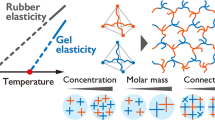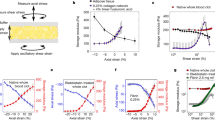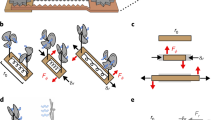Abstract
When subject to stress or external loads, most materials resist deformation. Any stable material, for instance, resists compression—even liquids. Solids also resist simple shear deformations that conserve volume. Under shear, however, most materials also have a tendency to expand in the direction perpendicular to the applied shear stress, a response that is known as positive normal stress1. For example, wet sand tends to dilate when sheared, and therefore dries around our feet when we walk on the beach. In the case of simple solids, elastic rods or wires tend to elongate when subject to torsion2. Here, we show that networks of semiflexible biopolymers such as those that make up both the cytoskeleton of cells and the extracellular matrix exhibit the opposite tendency: when sheared between two plates, they tend to pull the plates together. We show that these negative normal stresses can be as large as the shear stress and that this property is directly related to the nonlinear strain-stiffening behaviour of biopolymer gels3.
This is a preview of subscription content, access via your institution
Access options
Subscribe to this journal
Receive 12 print issues and online access
$259.00 per year
only $21.58 per issue
Buy this article
- Purchase on Springer Link
- Instant access to full article PDF
Prices may be subject to local taxes which are calculated during checkout




Similar content being viewed by others
References
Ferry, J. Viscoelastic Properties of Polymers (Wiley, New York, 1980).
Poynting, J. H. On pressure perpendicular to the shear planes in finite pure shears, and on the lengthening of loaded wires when twisted. Proc. R. Soc. Lond. A 82, 546–559 (1909).
Storm, C., Pastore, J. J., MacKintosh, F. C., Lubensky, T. C. & Janmey, P. A. Nonlinear elasticity in biological gels. Nature 435, 191–194 (2005).
Bustamante, C., Marko, J. F., Siggia, E. D. & Smith, S. Entropic elasticity of lambda-phage DNA. Science 265, 1599–1600 (1994).
MacKintosh, F., Käs, J. & Janmey, P. Elasticity of semiflexible biopolymer networks. Phys. Rev. Lett. 75, 4425–4428 (1995).
Gittes, F. & MacKintosh, F. Dynamic shear modulus of a semiflexible polymer network. Phys. Rev. E 58, R1241–R1244 (1998).
Gardel, M. L. et al. Elastic behavior of cross-linked and bundled actin networks. Science 304, 1301–1305 (2004).
Schmidt, C. F., Bärmann, M., Isenberg, G. & Sackmann, E. Chain dynamics, mesh size, and diffusive transport in networks of polymerized actin. A quasielastic light scattering and microfluorescence study. Macromolecules 22, 3638–3649 (1989).
Lin-Gibson, S., Pathak, J. A., Grulke, E. A., Wang, H. & Hobbie, E. K. Elastic flow instability in nanotube suspensions. Phys. Rev. Lett. 92, 048302 (2004).
Montesi, A., Pena, A. A. & Pasquali, M. Vorticity alignment and negative normal stresses in sheared attractive emulsions. Phys. Rev. Lett. 92, 058303 (2004).
Rivlin, R. S. Large elastic deformations of isotropic materials. II. Some uniqueness theorems for pure, homogeneous deformation. Phil. Trans. R. Soc. Lond. A 240, 491–508 (1948).
Rivlin, R. S. Large elastic deformations of isotropic materials. IV. Further developments of the general theory. Phil. Trans. R. Soc. Lond. A 241, 379–397 (1948).
Rivlin, R. S. & Saunders, D. W. Large elastic deformations of isotropic materials. VII. Experiments on the deformation of rubber. Phil. Trans. R. Soc. Lond. A 243, 251–288 (1951).
Wang, L. Z. et al. Purification of salmon clotting factors and their use as tissue sealants. Thromb. Res. 100, 537–548 (2000).
Leterrier, J. F., Kas, J., Hartwig, J., Vegners, R. & Janmey, P. A. Mechanical effects of neurofilament cross-bridges. Modulation by phosphorylation, lipids, and interactions with F-actin. J. Biol. Chem. 271, 15687–15694 (1996).
Acknowledgements
This work was supported by the US National Institutes of Health, the NSF MRSEC program, the CompInt program of the Elitenetzwerk Bayern, the (Netherlands) Foundation for Fundamental Research on Matter (FOM) and the NSF through the Kavli Institute for Theoretical Physics at the University of California. We are grateful to T. Lubensky and R. Bucki for helpful discussions.
Author information
Authors and Affiliations
Corresponding authors
Ethics declarations
Competing interests
The authors declare no competing financial interests.
Supplementary information
Supplementary Information
Supplementary information (PDF 50 kb)
Rights and permissions
About this article
Cite this article
Janmey, P., McCormick, M., Rammensee, S. et al. Negative normal stress in semiflexible biopolymer gels. Nature Mater 6, 48–51 (2007). https://doi.org/10.1038/nmat1810
Received:
Accepted:
Published:
Issue Date:
DOI: https://doi.org/10.1038/nmat1810
This article is cited by
-
Role of viscoelasticity in the appearance of low-Reynolds turbulence: considerations for modelling
Journal of Biological Engineering (2024)
-
On the coupling of rectilinear shear and stretching in a slab made of incompressible elastic neo-Hookean materials: analytic formulation and finite element validation
Meccanica (2023)
-
Simulating cylinder torsion using Hill’s linear isotropic hyperelastic material models
Mechanics of Time-Dependent Materials (2023)
-
Further Results on Stretch Formulations of Simple Shear and Pure Torsion for Incompressible Isotropic Hyperelastic Materials
Journal of Elasticity (2023)
-
Fibrous hydrogels under biaxial confinement
Nature Communications (2022)



